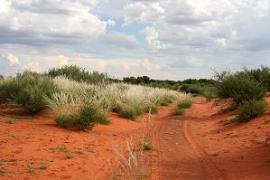The fascination of the Kalahari Desert

The Kalahari Desert is a vast expanse of arid land which extends from South Africa to Namibia and Botswana. In fact the Kalahari is not really a desert as it can support some animals and plants and early settlers managed to live on the arid land and survive the harsh conditions.
Bushman have lived in the Kalahari Desert for more than 20,000 years as hunters and gatherers, and in the early 1870s the first White settlers came to live on the land.
The following article about the white settlers in the Kalahari Desert was generously sent in to ExpatCapeTown by Cav. A. Martinaglia.
Farmers in the Kalahari Desert
The most forbidding solitudes occupied by White farmers in Namibia, during those pioneering days were along the Kalahari Desert frontier with Namibia.
What of those who spend their lives in that grim borderland.
What keeps them there? I have often wondered.
Away to the east there is Kalahari country like park sprinkled with trees and sometimes covered with yellow grass. Along the Namibian frontier, where it runs due north from Nakop, there are just the red or golden dunes according to the time of day. They run in parallel lines, each valley exactly like the one already left, so it can be so easy to loose one’s way.
Some settlers have, as it has been recorded, in fact lost their way and died there of thirst in those early days. Once rainfall occurs, of course that changes the whole situation in general, but at times, there is not a drop falling from the sky. This is the kind of area for some unknown mystery gripped men, women and children to spend their lives there in this remote part of the world. To any logical thinker, this is the real mystery of the frontier.
Scotsmann Hill negotiates with the Khoi
During the 1870’s came the first white man who decided to settle in this wilderness. A Scotsman, by the name of Hill, who was accompanied by his wife and family was able to negotiate land from the local Khoi Bondelswart chieftain by the name of Willem Christian.
Over a good bottle of brandy the agreement was reached that Hill could saddle a horse and ride for two hours in the same direction, thereafter changing course for another two hours putting down marked beacons each time, until the square was completed.
All the land covered in this way would then have his ownership. In this way Hill secured three farms for a sum of 800 English Pounds! The farms were named "Tsawasis", "Holoog" and "Groendoorn".
Swiss Carl Wilhelm Walser settles in the Kalahari Desert
Then not too long thereafter a Swiss by the name of Carl Wilhelm Walser who came riding in on a ox, and was immediately taken in by Hill, marrying his daughter shortly thereafter.
So the process for negotiating land for Walser this time started it’s second phase, by way it was done with Hill. The horse-racing method once again applied, with Walser owning the farms "Ukamas", "Walserbrunn", "Ariamsvlei", "Nakop", and "Swartkop".
Looking at this vast area of land at first glance, one would wonder how would it be possible to make it profitable? Walser soon began to think of the Israelites surviving in the desert, and this made him realize that he should use simply edible tamarisk and acacia gum, released by boring beatles, and that these trees are not only to be found in the Sinai Desert, but also in Namibia.
Soon Walser had a workforce in motion, collecting gum from the trees along the dry river beds. There was white gum, which was almost transparent, used by sweet factories, and a yellow gum, known as Arabic gum. The Roman Catholic Church at Heirachabis (meaning the place of plenty of gum) actually are still using their people to gather these desert products to this very day.
Walser was at an advantage, which could have come at a better time with because of the war in Sudan, which was the normal obtainable source of these products at the time. Selling the gum at a higher price, he was able to put his profit into cattle breeding, and sent his children off to Switzerland to be educated.
Walser marketed the gum in London, where he paid occasional business visits to the importers. He became "lord of the frontier" indeed. For hours at a time, he and his son Charles would sit on a high dune, surveying the empire he had created in this lonesome part of the world.
All the wars left them unshaken, and even eventual drought could not force them to leave this place. Even the civil war with the German Colonists did not affect them, and while neighbouring farmers left the area, the Walsers remained at peace with their Khoi people, who did not harm them in anyway.
So life for Walser continued living up to the ripe old age of 90 years old, alone on the farm, except for his faithful Khoi servant, his son Charles passing away 5 years before him. Content to the end in this lonesome part of the world, where angels fear to tread!
I hope you enjoyed reading A. Martinaglia's account of early settler's history in the Namibian Kalahari Desert as much as I did.
Picture credit to Pieter Roos.